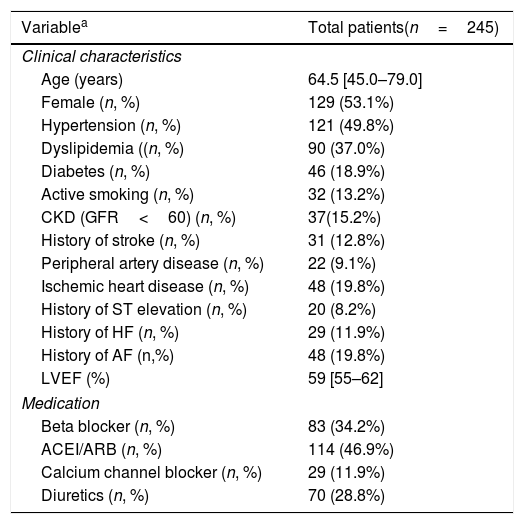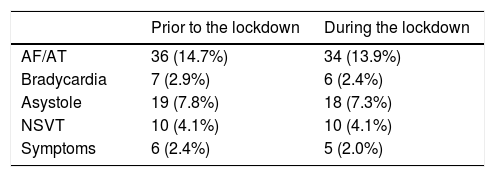To assess the changes induced by the COVID-19 lockdown on cardiac biometric variables recorded using an implantable cardiac monitor (ICM) in a patient population monitored for syncope work-up, as well to assess whether there has been an effect on arrhythmic events among the patients.
MethodsLongitudinal cohort study. We included 245 adult patients monitored with an ICM indicated for the investigation of syncope. The records from days 1 to 12 March 2020 (prior to the institution of lockdown by the state government) with days 16 to 28 March 2020 were compared.
ResultsDaily physical exercise reduced markedly after the imposition of lockdown (132 [55–233] minutes vs. 78 [21–154] minutes). The mean daytime HR prior to lockdown was 77 [69–85] bpm, whereas during lockdown it was 74 [66–81] bpm. During the lockdown period, a drop in the variability in heart rate (114 [94–136] ms vs. 111 [92–133] ms) was observed. Although the incidence of AF was similar over both periods, the daily AF burden was significantly higher post-lockdown (405 [391–425] minutes vs. 423 [423–537] minutes). No differences in the number of other arrhythmias were found.
ConclusionsThe establishment of mandatory lockdown has led to a marked drop in daily physical activity in this population which probably explains changes observed in other cardiac biometric variables. Although, in the short term, we have not documented an increased risk of arrhythmia, we cannot rule out an effect in the medium to long term or in other populations of at-risk patients.
Evaluar los cambios inducidos por el confinamiento durante la pandemia de COVID-19 en las variables biométricas cardiacas registradas, utilizando un monitor cardíaco implantable (ICM) en una población de pacientes monitorizada para el diagnóstico de síncope, así como evaluar si ha habido un efecto sobre los eventos arrítmicos.
MétodosEstudio de cohorte prospectivo. Se incluyeron 245 pacientes adultos monitorizados con un ICM indicado para la investigación del síncope. Se compararon los registros de los días uno al 12 de marzo del 2020 (antes del establecimiento del confinamiento por parte del gobierno estatal) con los días 16 al 28 de marzo del 2020.
ResultadosEl ejercicio físico diario se redujo notablemente después de la imposición del confinamiento (132 [55 a 233] vs. 78 [21 a 154] min). La frecuencia cardiaca diurna media antes del confinamiento fue de 77 (69 a 85) lpm, mientras que durante el mismo fue de 74 (66 a 81) lpm. Durante el período de confinamiento, se observó una disminución de la variabilidad de la frecuencia cardiaca (114 [94 a 136] vs. 111 [92 a 133] ms). Aunque la incidencia de fibrilación auricular (FA) fue similar en ambos períodos, la carga diaria de FA fue significativamente mayor después del bloqueo (405 [391 a 425] vs. 423 [423 a 537] min). No se encontraron diferencias en el número de otras arritmias.
ConclusionesEl establecimiento de un confinamiento obligatorio ha provocado un marcado descenso de la actividad física diaria en esta población, lo que probablemente explica los cambios observados en otras variables biométricas cardiacas. Si bien, a corto plazo, no se ha documentado un aumento del riesgo de arritmia, no podemos descartar un efecto a medio-largo plazo o en otras poblaciones de pacientes de riesgo.










